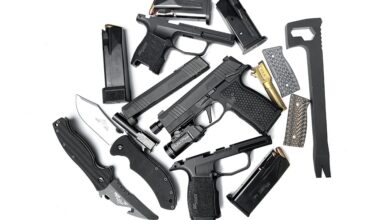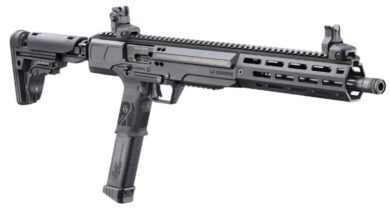JSSAP: How We Got the M9

Did you know that we got the Beretta M9 because a congressional investigation revealed that the Air Force had 25 different handguns in its inventory? The Air Force wanted special permission to acquire ammunition for its beat-up M15 revolvers. Someone asked why the Air Force had revolvers, which launched the investigation into the handguns of the United States military.
The Air Force had revolvers because it couldn’t acquire any M1911s. Instead, it purchased S&W M15 .38 Specials in 1962. In 1962, no one looked at the Air Force’s request and questioned it. They signed off on the revolvers, and they got them. In 1977, they requested special ammo, and in what turned out to be a quenching moment for the Air Force, Congress took note of this odd request.
Congressman Joseph P. Addabbo was a big advocate for responsible defense spending, and he was at the right place, at the right time, to raise a stink about the Air Force’s special revolvers. The Congressman was famously quoted as saying, “The current proliferation of handguns and handgun ammunition in Air Force inventory is intolerable.” The result of that investigation was a Congressional suggestion that the military decide on one handgun and get rid of everything else.
JSSAP: Teamwork Makes the Dreamwork
The Congressional suggestion became the Joint Service Small Arms Program (JSSAP) in 1978. The original four voting members, the US Army, Navy, Air Force, and Marine Corps, united under the JSSAP’s banner. This program was a beacon of standardization, ensuring uniformity across the diverse forces of the United States military.
Their first task was to find a replacement for the M1911A1 and to standardize handguns. Officially, the M1911A1 was the official service sidearm of the Marine Corps, Army, and Navy. The Air Force, in their bid to be different, adopted the S&W M15.
While the M1911A1 might have been the official sidearm of three branches, several other handguns were circulating among those same three branches. The S&W and Colt M1917 revolvers were still being issued. Various .38 Special revolvers were used by military police forces. S&W K-38s were the most common, but Ruger Security Sixes were also purchased in limited numbers.
JSSAP had to wipe the board clean of what was a potluck of American gun manufacturers and find one gun to do it all. This became the XM9. After two years of making sure 9mm would be good enough for their next gun, the project launched in 1980.
The Birth of the XM9
The XM9 project had 85 requirements, and 72 were mandatory. The basic requirements included:
- Chambered in 9×19 to standardize with NATO.
- Detachable 13-round magazine.
- Drop-free magazines
- DA/SA design
- Slide stop that locks the slide open when the magazine is empty
- Durability of 5000 rounds with no more than eight malfunctions
- Ambidextrous thumb-safety system
- De-cocking device to safely lower a cocked hammer
- Firing pin block, for when the hammer is lowered
Overall, the XM9 called for modernizing the 9mm handgun. The Air Force led the charge on the XM9 and invited various gunmakers to enter the contest. Six companies responded.

- Smith & Wesson entered with the S&W 459A
- HK entered with the P9S and the VP70
- Colt submitted the Colt SSP, a 9mm variation of the Colt Model 1971
- FN entered the venerable Hi-Power and the FN Browning Fast Action, which was a modified Hi-Power
- Star Bonifcacio Echevveria S.A. entered their Star Model 28
- Beretta put forth the Beretta 92S-1
These entries were put against the M1911 and M15 as control points.
Gun-savvy readers will be quick to point out that guns like the Browning Hi-Power and VP70 didn’t quite meet the requirements with their operating designs. However, this is often the case, and manufacturers try their hardest to get their guns in the contest regardless.
JSSAP, Testing the Champs
These guns were put through a battery of tests. The Air Force used a hot room, to heat the guns to 125 degrees and then fire them. They tossed them into the -60-degree cold room and let them rip. They threw them into a cement mixer full of mud and checked their reliability. The guns were also tested for their ease of accuracy by various Air Force personnel with differing levels of firearms experience.

In testing, the various 9mm guns were found to be more accurate, and easier to shoot than the M1911 and the M15. The new guns proved to be more reliable. The M1911 had a stoppage of roughly 748 rounds, although this was controversial because the M1911 failures were blamed on old magazines. The eventual winner of the Air Force trials, the Beretta 92S-1, had one failure in 2,000 rounds.
The Air Force declared the Beretta the winner, but the Army protested and invalidated all test results because the Air Force didn’t replace the M1911 magazines (they should have shopped at GunMag Warehouse).
JSSAP, likely rubbing their foreheads and sighing in frustration, agreed to let the Army conduct their own testing.
The Army Testing
The Army released its requirements. They were essentially the same as the Air Force but called for a magazine capacity of 10 rounds, rather than 13. The Army put out their needs and wanted 30 pistols from each contestant, and required a firm bid for 220,000 pistols.
Several of the companies felt the need for 30 pistols, and the firm bid was delivered without enough notice, so they declined to enter. Beretta and Smith & Wesson were the only companies to enter their original Air Force test guns. HK entered their new P7, and Sig Sauer entered the P226, both of which would become legends in their own right.
Everything went radio silent until February 1982. The Army dropped a major bomb with a single statement,
“The Army, in its role as Defense Department executive agent for 9mm handgun procurement, has canceled the procurement. It was not possible to make an award because the submitted weapon samples substantially failed to meet the essential requirements contained in the procurement solicitation. The Department of Defense intends to reexamine its requirements for a new handgun.”
Let’s talk uproar. The Germans were so furious they penned a strongly worded letter, the Italians set a record for talking with their hands, and Smith & Wesson sold their handguns to the FBI. I’m making up two-thirds of that, but needless to say, the companies were mad, and so were the Congressional supporters of the program.

The Army claimed that the guns failed their testing but supplied no data, claiming that it would compromise the next competition. Congressman Addabbo demanded a full written account of the Army tests and threatened a Congressional investigation if they were not delivered.
The Third Test
The uproar was enough that in November of 1983, a new testing and procurement process was established by the Army. Capacity was moved back to 13 rounds and the Army provided enough notice to receive 30 pistols from each entry. The Army received eight contestants.
- Beretta 92SB-F, aka the 92F, a slight improvement on the 92SB-1
- The SIG P226
- The Steyr GB
- The FN BDA, a double-action version of the Hi-Power
- Colt SSP
- Walther P88
- HK P7M13
- S&W 459M, a slight improvement on the 459A
The Army put the entries through a battery of tests. The Steyr GB was the first to be dropped. FN and Colt voluntarily withdrew their entries. The Walther P88 failed the drop test, dispersion, corrosion resistance, and adverse conditions requirements. The P7M13 failed the failing reliability and corrosion resistance requirements. The S&W 459M failed the service life and firing pin energy requirements.

The Winner
This left the Beretta and Sig Sauer entries. Beretta had the lower bid, and thus, the M9 became the standard service sidearm. It wasn’t without controversy, and by 1988, the XM10 trials started and ended with Beretta winning again. Of the four contests Beretta entered, it won three and tied for last place in the original Army testing.
The Beretta would go into service from 1985 until 2017, when the Sig Sauer P320-M17 replaced the Beretta. However, military procurement has been slow. As I type this in 2024, the M9 still serves across every branch. It will be quite some time before the M9 sees its last sunset.
The post JSSAP: How We Got the M9 appeared first on The Mag Life.
Read the full article here






